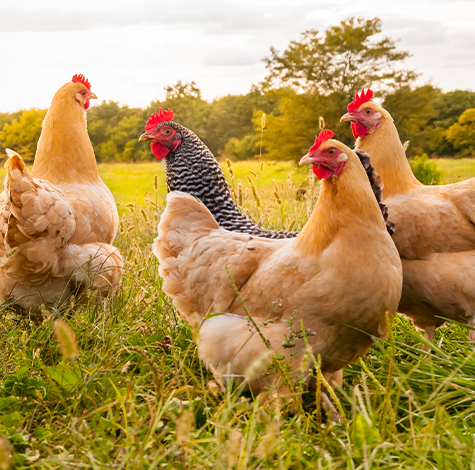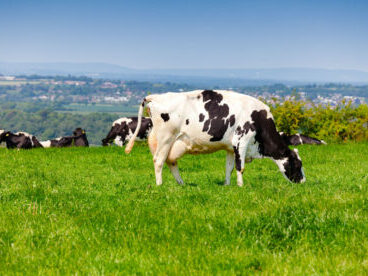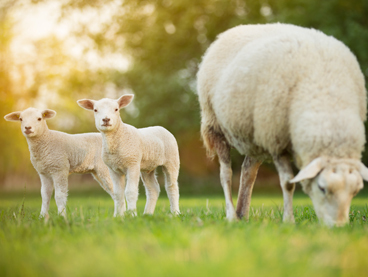Gloucestershire producers Richard and Neil Robinson believe the key to maintaining performance from their 200 head herd is paying close attention to what the cows were telling them and fine tuning the diet.
Fine tuning drives performance from a simple system
Gloucestershire producers Richard and Neil Robinson believe the key to maintaining performance from their 200 head herd is paying close attention to what the cows were telling them and fine tuning the diet.
The Robinsons run a very simple system on the traditionally laid out unit near Tewkesbury. The cows graze in the summer and are buffer fed, with dairy compound in the parlour. They are fed a TMR diet in the winter. The farm has no mixer wagon and the diet is layered into round feeders using a skid steer loader with the cows doing their own mixing. The 340 acre tenanted farm is mainly down to grass for the cows and 120 followers which calve in at two years old. Around 70 acres of maize are grown every year along with 15 acres of fodder beet.
The Robinsons are achieving an excellent level of performance from the all year round calving closed herd. Yields average 10,300 litres and the herd includes 50 cows classified EX, 50 VG cows, one 120 tonne cow, two 110 tonne cows and three 100 tonne cows. Milk is sold on a white water contract to Cotteswold Dairies.
The cows are run as one milking group with two dry cow groups – far off dry and one month from calving.
“We try to base the system on quality forage,” comments Neil Robinson. “We reseed around 30 acres annually to maintain grass productivity and use a combination of forages to spread the risk. We aim for three cuts of grass silage and have been growing fodder beet since 1984 as we find it suits the farm. We are lucky to have a very good contractor and typically get around 35t/acre.”
Difficult 2012
The difficult forage season in 2012 meant they were struggling to get the performance they wanted and it was at this time Mike Chown from UFAC UK first visited the unit.
The diet then comprised of maize and grass silage, 6kg fodder beet per cow and 3kg of a blend comprising wheat, rape, soya, home produced maize grain, wheat distillers, sugar beet pulp, minerals, AcidBuf and a palm oil based fat. The bespoke blend is mixed by Abbey Farmers and an 18% dairy cake was fed in the parlour. The maize silage is put in the feeders first followed by the blend, the grass silage, the fodder beet and finally hay.
“When I walked the cows I was concerned by a number of things,” Mike Chown recalls. “There was excess body condition (BCS) loss in early lactation and a significant amount of variation in the dung with undigested feed passing through the cows, signalling an issue with acidosis. “As the cows can be away from fibre for a long time while the feed was being put out and around milking at which time they could get 4kg of concentrates as well, I advised making hay available in the collecting yard so cows could increase fibre intakes to help buffer rumen pH. We also tweaked the protein in the blend as the cows were short of bypass protein, replacing some of the rape and distillers with Promega which is high in bypass protein and omega 3s which would also help fertility.” The impact of the changes was more consistent dung and higher peak yields.
Reduce parlour feeding Continuing the theme of better rumen health, Mike encourages Neil to reduce parlour feeding, something that was made easier as new parlour software had been installed. The aim was to reduce the acid loading on the rumen and encourage a higher DMI of feeds produced on the farm.
Being concerned at the extent of BCS loss, Mike wanted to try and increase energy supply while controlling acidosis risk and advised Neil to swap the palm oil based fat for Dynalac, a softer fat based on rape, sunflower and soya oils. This makes it easier to digest, so releasing energy more effectively than the harder short chain saturated fatty acids that predominate in palm oil based products.
“We wanted cows in positive energy balance by day 40 of lactation. The higher digestibility combined with the fact that the fat is rumen inert increased energy supply. Being rumen inert is really important. It means that unlike calcium soaps which can breakdown in the rumen when pH is particularly low, it passes through the rumen with minimal degradation before being absorbed in the hind gut ensuring increased energy availability.”
Changing fats increases yields
Neil agreed to try a weight for weight swap for a five week trial period and was pleased with the results.
“As soon as we changed fats we saw an increase in peak yields,” Neil Robinson comments. “When we switched back again the cows did not yield as well and many fell away more quickly so we swapped back to Dynalac again and it remains in the blend we are buffer feeding now.”
Fertility has also improved, in part due to better management of BCS and in part due to the effect of the omega 3s. Conception to first service has increased and the voluntary waiting period has been reduced to 42 days, “Improving rumen health has lead to a reduction in concentrate feeding rates and we will be feeding less than two tonnes of concentrate per cow, down from closer to three tonnes,” Mike Chown continues.
“We have reduced the cost of the blend and the better rumen health means that the AcidBuf inclusion rate has been halved, saving £300 per month.” Looking forward Neil plans to convert a barn to provide pre-calving accommodation and will look to form a group of cows in the first three weeks of lactation. “Housing these cows separately will allow us to monitor intakes and get cows settled into lactation better. “We also plan to increase herd numbers up to around 220 cows while maintaining a closed herd. We will then focus on milk from forage and improving fertility still further while preventing the unit coming under too much pressure.”


 Back to News
Back to News 



